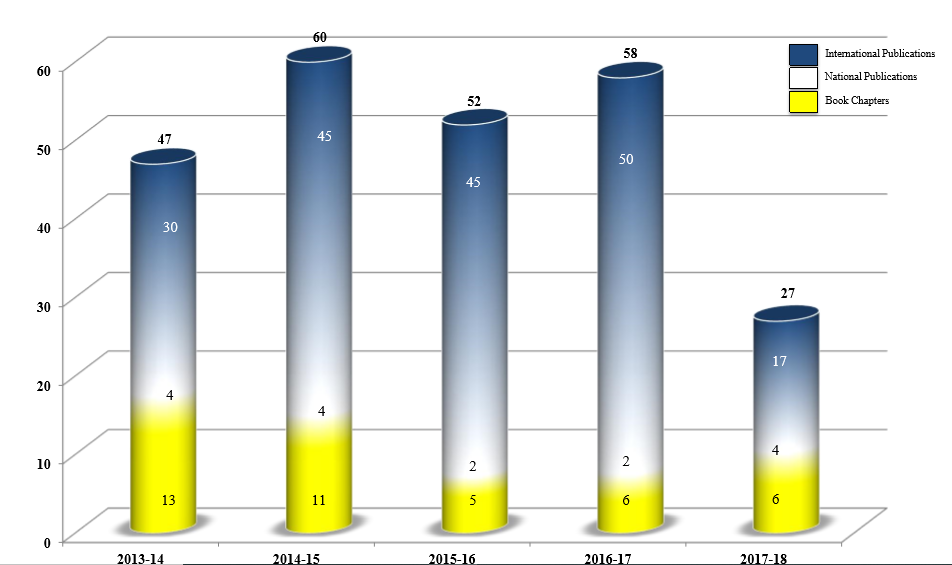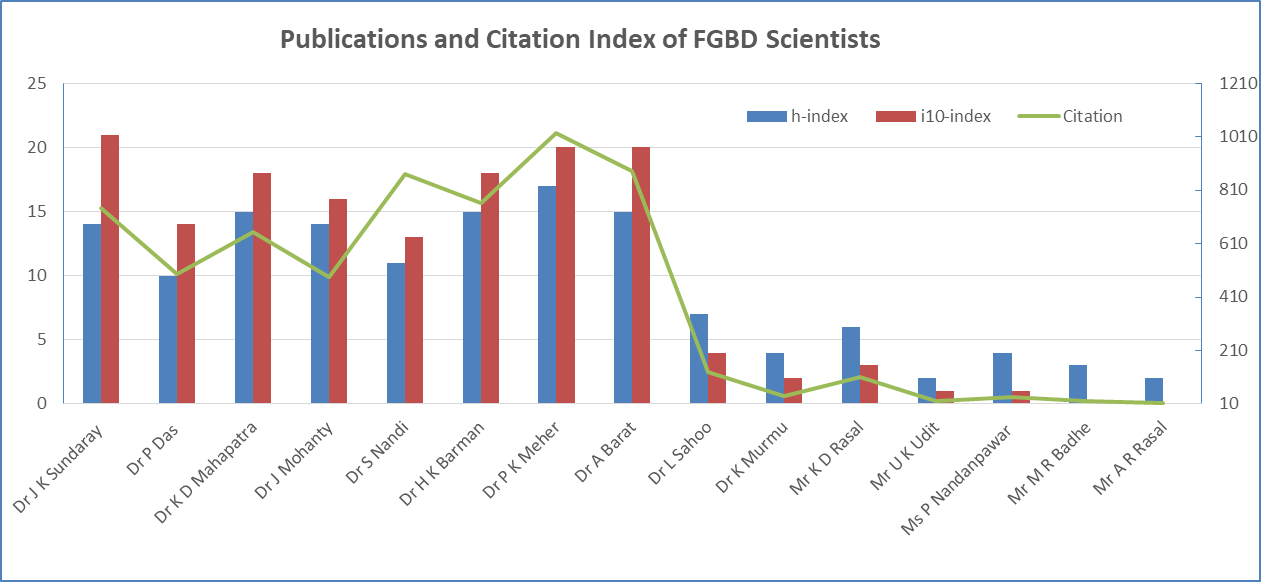- Screen Reader >>
- Skip to Main Content >>
- T
- T
- T
- T
- Font Size:
- A- A A+
- Help
- FAQs
- Contact Us
मत्स्य आनुवंशिक एवं जैवप्रोदयोगिकी प्रभाग
मत्स्य आनुवंशिक एवं जैवप्रोदयोगिकी प्रभाग
Goal
Evolving genetically improved varieties of prioritized fish and shellfish species
Objectives
- To develop genetically improved varieties of fish and shellfish
- To develop an integrated cost effective Marker Assisted Selection (MAS) program at national level in carp & prawn species
- To study OMICS biology for better yield of fish and prawn
- Promoting HRD program under cutting edge technology in Division
Major Area of Research
- To develop genetically improved varieties of fish and shellfish through selective breeding
- To understand genetic variation among commercial important species with respect to performance traits and harness for breeding
- To develop an integrated cost effective Marker Assisted Selection program at national level in carp & prawn species
Approaches
- Genetic selection
- Implementation of genomic tools and genomic selection
- Gene edited carps to improve growth
- Integration of broodstock diet and improve variety to produce quality seed
Performance measure
- Propagations of improve varieties across the globe
- Fish with good quality flesh
- Expanding the horizon for quality fish seed production
| Scientific Staff | |
|
|
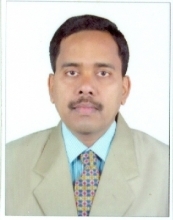 |
|
|
 |
|
|
 |
|
|
 |
|
|
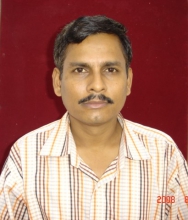 |
|
|
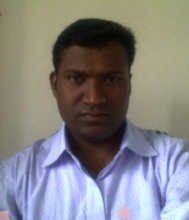 |
|
|
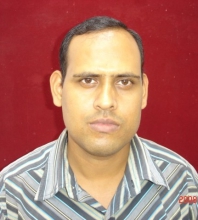 |
|
|
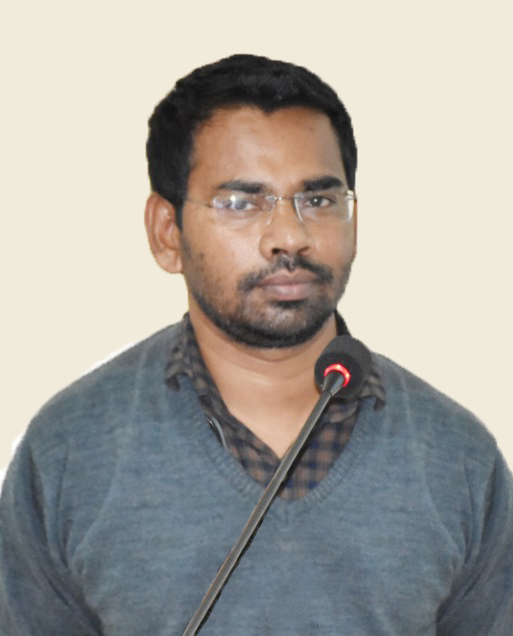 |
|
|
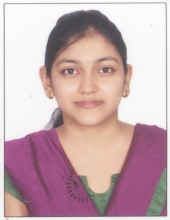 |
|
|
 |
|
|
 |
Project Personnel
| Rajiv Gandhi National Fellow | Minati Manjari Soren |
| Senior Research Fellow | 1. Sonalina Sahoo 2. Ipsita Iswari Das |
| Junior Research Fellow | 1. Bismay Sahoo |
| PhD student | 1. Nirjharini Priyadarshini |
| Young Professional–I | 1. Sthitiprangya Chand |
| Young Professional–II | 1. Dipti Ranjan Bag 2. Harshita Singh |
| Technical/Field Assistants | 1. Prabir Kumar Swain 2. Biswajit Mallik |
Visitors in the FGBD and Farm facility
- Visit of Hon. Union minister of fisheries, Shri.Giriraj Singh on 26th February 2020
- Field Visit of Mr. Helge Tryti, Commercial Counsellor, Norwegian Embassy, New Delhi on 30 January 2019
- 2ndAdvisory board members of Indian Network of Fisheries and Animal Antimicrobial Resistance (INFAAR) visited FGBD, ICAR-CIFA on 27th Oct, 2018
- Visit of Dr. Ninawe – DBT Advisor on 15-05-2015 and Dr. A K Singha DDG, Agriculture Extension and Fy Science
- Field visit of Dr. K. N. Kumar, IAS, Chief Executive, NFDB (04 – 08-2015)
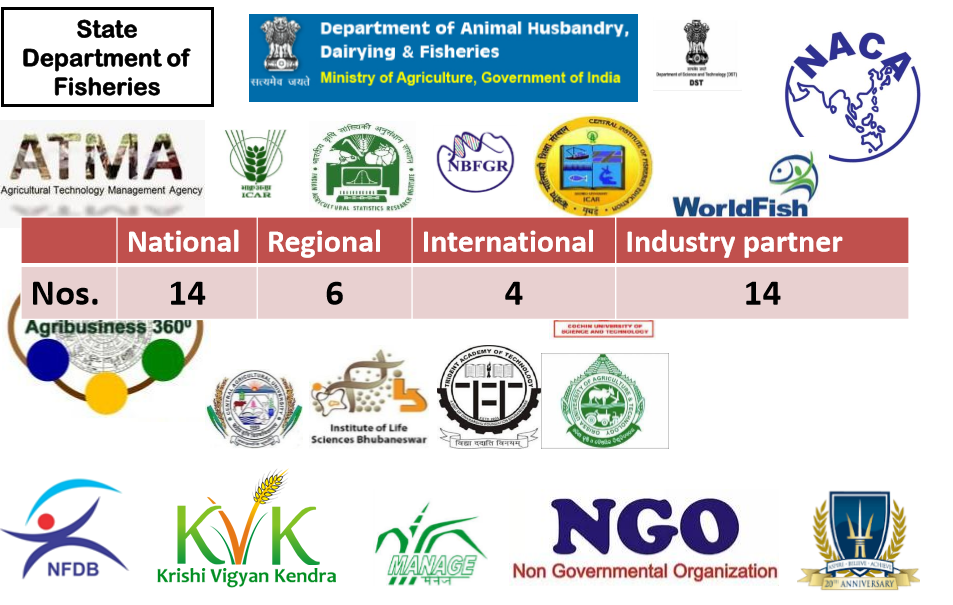
FGBD collaborators
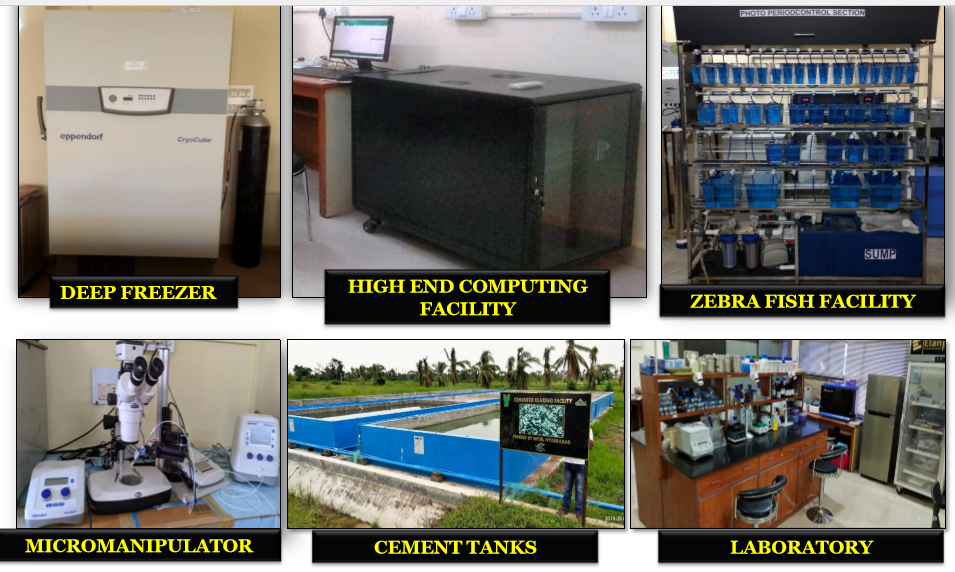
Infrastructure available with FGB Division
Institute based On-going Projects
| # | Project Title | PI | Duration |
|---|---|---|---|
| 01 | Genetic improvement of rohu (Labeo rohita) for growth and disease resistance against A. hydrophila and its effective dissemination | Dr. K. D. Mahapatra | 2018-21 |
| 02 | G/E interaction evaluation for growth rate of Jayanti rohu in different parts of India | Dr. Khuntia Murmu | 2017-20 |
| 03 | Genetic characterization of Indian populations of Clarius magur | Dr. Laxman Sahoo | 2017-20 |
| 04 | Implication of fat accumulation on gonadal maturation in Catla catla | Uday Udit | 2019-21 |
| 05 | Proteomic analysis of differentially expressed proteins in rohu, Labeo rohita in response to heat stress | Mohan Badhe | 2017-20 |
Externally Funded On-going Projects
| # | Project Title | PI | Funding Agency | Duration |
|---|---|---|---|---|
| 01 | Centre of Excellence on Genetic enhancement of economically important freshwater fish, Catla catlausing genetic and molecular approaches | Dr. J. K. Sundaray | DBT | 2018-20 |
| 02 | Deciphering Genetic Variation in the Carbohydrate Metabolism of Farmed Rohu Families | Dr. J. K. Sundaray | ICAR-CABin | 2017-20 |
| 03 | Improved broodstock management and quality seed production of Ompok bimaculatus thorough application of molecular endocrinology | Dr. J. K. Sundaray | DBT | 2018-21 |
| 04 | Ecological assessment of the exotic sailfin catfishes in the Indian freshwater systems and developing a species specific molecular tool to measure their detection in the wild (Collaborative project) | Dr. J. K. Sundaray | SERB | 2018-21 |
| 05 | Assessment of endocrine disruption in fish reproduction | Dr. J. K. Sundaray | DBT | 2019-22 |
| 06 | Development of genetic resources in A.testudineus for breed improvement and understanding molecular mechanisms involved in hypoxia tolerance | Dr. P. Das | DBT(BIO-CARE) | 2017-20 |
| 07 | Novel approaches towards vaccine development against argulosis in carps | Dr. J. Mohanty | CRP-VACCINES | 2015-20 |
| 08 | Value addition by generating stable lines of ornamental transgenic freshwater fishes | Dr. H. K. Barman | DST | 2017-20 |
| 09 | To elucidate the unique biochemical adaptational strategies that allow two air-breathing catfishes (Clarias batrachus and Heteropneustes fossilis) to survive in ammonia enriched toxic waste. | Dr. H. K. Barman | NASF | 2018-21 |
| 10 | Establishment of captive breeding protocols and value additions to selected indigenous ornamental fishes from North East India | Dr. H. K. Barman | DBT | 2018-21 |
Project Collaboration with other Institute/Division
| # | Project Title | Collaboration with | PI/Co-PI | Duration |
|---|---|---|---|---|
| 01 | Molecular screening, cell culture based isolation and characterization of finfish and shell fish virus and establishment of national repository (DBT Funded) |
Cochin University, ICAR-CIFE, Sher-e-Kashmir University of agricultural sciences, C. Abdul Hakim College, Tamil Nadu | Dr. J. Mohanty | 2017-20 |
| 02 | Dissemination of minor carp production technologies sand its refinement for adoptability by the aqua culture farmers (NFDB Funded) |
APED, ICAR-CIFA | Dr. K. Murmu | 2018-21 |
| 03 | Capacity Building of Knowledge Intermediaries and Primary Stakeholders in Freshwater Aquaculture through Virtual Learning Approach (NFDB Funded) |
Social science section, ICAR-CIFA | Avinash Rasal | 2018-20 |
| 04 | Deciphering Genetic Variation in the Carbohydrate Metabolism of Farmed Rohu Families(ICAR-CABin) | ICAR-IASRI, New Delhi | Dr. J. K. Sundaray | 2017-20 |
| 05 | Improved broodstock management and quality seed production of Ompokbimaculatus thorough application of molecular endocrinology (DBT Funded) |
College of Fisheries, CAU, Agartala | Dr. J. K. Sundaray | 2018-21 |
| 06 | RKVY project on Farm based S & T Intervention for socio-economic development in the aspirational district of Nabarangpur, Odisha (ICAR-CIFA component) (Externally funded: CSIR-IMMT, Bhubaneswar) | 12 ICAR and CSIR institutes in Bhubaneswar | Dr. K. Murmu | 2019-20 |
| 07 | Assessment of endocrine disruption in fish reproduction | Vishwa Bharathi University, ICAR CIFRI and ICAR CIFA | Dr. J. K. Sundaray | 2019-22 |
International Collaboration
| # | Project Title | PI/Co-PI | Duration |
|---|---|---|---|
| 01 | ICAR-WorldFish collaborative project on “Sustainable aquaculture entitled “Development of sustainable aquaculture practices through lifecycle analysis (LCA) of selected aquaculture production systems and performance evaluation of improved varieties of carp and freshwater prawn”. | Dr. K. D. Mohapatra Dr. K. Murmu A. Rasal |
2019-20 |
Completed Projects (Institute based)
| # | Project Title | PI | Duration |
|---|---|---|---|
| 01 | Stock evaluation of Catla (Catla catla) for establishment of base population and selective breeding of rohu for two traits (growth and disease resistance against aeromoniasis) | Dr. K. D. Mohapatra | 2011-15 |
| 02 | In vitro production of fertile sperms from the testicular cells of Clarias batrachus | Dr. H. K. Barman | 2012-15 |
| 03 | Transcriptomic profiling of the reproduction related tissues during transition from post – spawning regression to initiation of gonad activity in rohu | Dr. S. Nandi | 2012-16 |
| 04 | Development of single nucleotide polymorphism in Labeo rohita and M. rosenbergii | Dr. P. Das | 2013-16 |
| 05 | Development of genomics resources in Indian major carp, Catla catla | Dr. Laxman Sahoo | 2013-16 |
| 06 | Establishment of base population for genetic improvement of Labeo bata(Hamilton, 1822) | Dr. P. K. Meher | 2013-16 |
| 07 | Establishment of base population and stock evaluation of Indian major carp, Cirrhinus mrigala | Dr. K. Murmu | 2013-16 |
| 08 | Proteomic analysis of differentially expressed proteins in giant freshwater prawn, Macrobrachium rosenbergii in response to biotic stressors | Dr. J. Mohanty | 2013-16 |
| 09 | Effect of CIFABROOD™ on the breeding performance and seed quality of Jayanti rohu (Labeo rohita) | Dr. J. N. Saha (01.04.2014 to 31.10.2015) Dr. S. Nandi (01.11.2015 to 31.03.2017) |
2014-17 |
| 10 | Selective Breeding of Catla (Catla catla) for growth improvement and two traits (growth & disease resistance against A. hydrophila) selection & dissemination of genetically improved rohu (Labeo rohita) |
Dr. K. D. Mohapatra | 2015-18 |
ICAR Outreach Activity
| # | Project Title | PI | Duration |
|---|---|---|---|
| 01 | Outreach Activity on Fish Genetic Stocks Phase II | Dr. P. Das | 2015-19 |
Completed Projects (Externally Funded)
| # | Project Title | PI | Duration | Funding |
|---|---|---|---|---|
| 01 | Development of molecular marker base d seed identification system of cultured carps(Cyprinids) | Dr. P. Jayasankar | 2011-14 | DST |
| 02 | Improvement of culture conditions, characterization and elucidating Oct4 mediated networking pathways for spermatogonial stem cells of Labeo rohita | Dr. H. K. Barman | 2011-15 | DBT |
| 03 | Development of a protocol for targeted integration of genes in Catla(Catla catla) | Dr. H. K. Barman | 2012-15 | NFBSFARA (ICAR) |
| 04 | Whole Genome Sequencing and Development of allied genomic resources in two commercially important fish: Labeo rohita, Clarias batrachus | Dr. P. Das | 2013-17 | DBT |
| 05 | Molecular and computational approach to delineate metabolic pathways for better carbohydrate utilization in Labeo species | Dr. J. K. Sundaray | 2014-17 | Network project on Agricultural Bioinformatics (IASRI) |
| 06 | Isolation and molecular cloning of hypoxia tolerant genes in Channa striatus | Dr. H. K. Barman | 2014-17 | DST |
| 07 | Novel approaches towards vaccine development against argulosis in carps | Dr. J. Mohanty | 2015-17 | ICAR (Consortia Research Platform on Vaccines and Diagnostics) |
| 08 | Development of a RNA interference based silencing approach targeting lectins (s) gene transcripts in freshwater prawn, M. rosenbergii and its implication as a biotherapeutic | Dr. J. Mohanty | 2016-19 | DBT |
| 09 | Deciphering gene structure and mechanism of Plzf gene expression in spermatogonial stem cells of rohu carp, Labeo rohita | Dr. H. K. Barman | 2015-18 | DST |
| 10 | In vitro propagation of spermatogonial stem cell (SSCs) of Clarias batrachus and production of fertile spawns from the propagating SSCs (INSPIRE Fellowship) | Dr. H. K. Barman | 2014-19 | DST |
| 11 | Stock improvement and quality seed production of important freshwater carp, catfish and prawn: prerequisite for NFFBB | Dr. K. D. Mahapatra | 2013-18 | NFDB |
| 12 | Development of a RNA interference based silencing approach targeting lectin(s) gene transcripts in freshwater prawn, M. rosenbergii and its implications as a biotherapeutant | Dr. J. Mohanty | 2016-19 | DBT |
| 13 | Three months national training programme in molecular biology and biotechnology for fisheries professionals | Dr. J. K. Sundaray | 2015-18 | DBT |
| 14 | Development of a RNAinterference-based silencing approach targeting lectin (s) gene transcripts in freshwater prawn, Macrobrachium rosenbergii and its implications as a biotherapeutant | Dr. J. Mohanty | 2016-19 | DBT |
Research
Genetic Improvement of cultivable species: Breed improvement for growth and disease resistance
- Selective breeding of rohu for higher growth
- Ten generations of selection completed with 18% average genetic gain per generation. Improved rohu (Jayanti) is disseminated to 16 states of India so far
- More than 200 lakhs of improved rohu (Jayanti) seed disseminated every year from the nucleus i.e. ICAR- CIFA to multiplier units and farmers from different parts of the country
- A study was conducted to investigate the effect of salinity on Improved rohu (Jayanti) and evaluation of its physiological response towards combating salinity stress. Fingerlings were reared in laboratory condition at different salinities to assess the effect of salinity on survival for the first time in India. The study revealed that exposure to salinity moderately affects the survival and physiological response of genetically improved rohu and thus the potential of the improved rohu (Jayanti) to tolerate salinity levels upto 8 ppt
- Improved rohu (Jayanti) has completed its life cycle in cement cisterns. Total living space is very important than individual living space for growth and maturity of Improved Rohu (Jayanti) in confined tanks
- Development of disease resistant (against Aeromonas hydrophila) rohu
- Under the selective breeding of rohu against hydrophila program, resistant line of rohu showed 58.3% higher survival compared to the susceptible line. Growth and disease resistant traits were found to be positively correlated. The resistant variety is under field trial.
- Resistant improved rohu against hydrophila produced and 500 number of advance fingerlings supplied to Bhimavaram for field trials. Till date, there no report of A. hydrophila infection from the field trials.
- Establishment of base population and selective breeding of Catla
- The base population of catla was developed from nine stocks belonging to different places of India. Two generations of selection is completed.
- Under Center of Excellence for Fish Genetics project, genetic improvement program for Labeo catla and associated molecular research such as development of genomic resources, proteomics of egg quality, molecular mechanisms associated with breeding window and live gene bank for improved catla has been recently initiated. A gene bank has been developed by preserving tissue samples of dam and sires contributing to formation of 22 full sib families (1st year) and 14 full sib families
- CIFABROODTM
- Breakthrough in breeding and seed production of IMCs using CIFABROODTM during December-January in Tamil Nadu reported that the increase in egg production (20-50%) and raising productivity of the female by 147 %, by producing more spawn per kg of brood stock.
- With use of this technology farmers able to advance breeding period by 60 days, i.e. normal breeding window (June to August) was extended upto April. The seed price is very high (Rs 1000- Rs1200 per lakhs of spawn) during early breeding season compared to price of Rs 400-600 during normal season (June-August)
- Enhances Seed production yield by 50% at Egg to Fry production of carps (With CIFABROOD avg. yield: 85-90% Other feed avg. yield: 35-40%)
- Whole Genome Sequence, genomic resources and Genetic characterization
- Whole genome sequence for Labeo rohita and Clarias magur has been completed. In total 182.5 Gb sequence data with 130x coverage was produced in case of rohita genome. The genome assembly and scaffolding was performed using MaSuRCA and SSPACE resulted with 13, 623 scaffolds with maximum scaffold size of 15.2 Mb covering about 95 % genome. In total 26400 protein coding genes were predicted in rohu genome. A total of 4, 967, 122 SNVs were identified using rohu draft genome as reference
- The first ever microsatellite and SNP based linkage maps in rohu was generated. Around 5 million of SNP has been identified
- Deciphered whole genome sequence of commercially important Indian major carp, Catla catla. >80x coverage sequence (60 Gb Illumina paired end + 20 Gb Nanopore data) to serve as a reference for marker discovery. The draft genome is submitted to GenBank
- Comparative genomics of catla with other cyprinids revealed 8494 protein coding genes in common with all the five species catla, L. rohita, C. idellus, D. rerio, A. grahami.
- A microsatellite based parentage analysis tool in Labeo rohita was developed
- A PCR based molecular identification system of rohu X catla hybrid was developed
- Developed polymorphic microsatellite markers in Labeo rohita, Labeo catla, M. rosenbergii, Clarias magur, Tor khudree. Tor khudree, due to its close resemblance with other Mahseer species, particularly Tor malabaricus, mitochondrial cytochrome oxidase I gene was used to identify them at species level before genetic characterization. Only 152 individuals from the total of 289 individuals collected were confirmed to be the said species
- Sequencing of mitochondrial ATPase 6 and 8 gene of Tor khudree from four populations (River TungaBhadra, Hospet; River Tunga, Shivmoga; River Periyar, Kerala and River Cauvery, Karnataka) was done and genetic diversity study revealed among population variation of 50.83% and within population variation of 49.17%, with 10 haplotypes
- Developed single nucleotide markers in Labeo rohita, Catla catla, M. rosenbergii, Clarias magur, anabas and Tor khudree
- Genetic characterization of the wild stocks of Labeo rohita, Catla catla, Cirrhinus mrigala, L. fimbriatus and M. rosenbergii
- Significant Haplotype genetic diversity (0.069 - 0.763) and genetic divergence (0.000114 – 0.00206) was observed within and among seven collected populations of Magur
- Reproductive manipulation
- Post-monsoon (August-September 2018) maturation and breeding of IMCs was successfully demonstrated in the hatcheries of Bihar and West Bengal
- CIFABROODTM fed rohu was bred first time at higher temperature (i.e. air 400C and water 350C) at Dighirahania govt. Fish farm, Balasore, and egg and spawn recovery was double than expected
- Pre-monsoon maturation and breeding was successful in the hatcheries of different states including Tripura, Assam, West Bengal, Odisha and Bihar under NFDB-CIFABROOD demonstration project
- Shorter latency period was observed in fish fed with CIFABROODTM compared to the control diet
- Spermatogonial stem cells (SSCs)
- Two step purification protocol of rohu SSCs was developed. SSC marker genes and mechanisms of expression was also identified
- Transcriptomics and miRNA mining
- Identified hypoxia tolerant transcripts/genes of C. striata
- Identified salinity tolerant transcripts/genes of rosenbergii
- Construction, De-Novo Assembly and Analysis of Transcriptome for Identification of Reproduction-Related Genes and Pathways from rohu, Labeo rohita (Hamilton) was done
- Glycemic profile of Labeo were analysed and glucose tolerance dose of 150mg/ml through intraperitoneal injection to the Labeo spp. were standardized
- miRNA sequencing of liver tissue samples of Labeo spp. was completed and differential gene analysis were carried out. 451 known and 354 novel miRNAs were identified in both rohu and bata samples and 19 differentially expressed miRNAs were investigated as their targets found in the metabolic genes. • The identified 138 known (conserved) and 161 novel liver specific miRNAs of Rohu can be used as a reference to develop inhibitors/promotor to block/enhance a pathway in liver
- Proteomics
- A 19 mer peptide selected through immunoproteomic approach shows potential as vaccine against fish ectoparasite, Argulus siamensis
- Isolation and characterization of two lectin molecules from hepatopancreas of freshwater prawn, Macrobrachium rosenbergii was done
- Identification of 21 differentially expressed proteins in hepatopancreas of rosenbergii in response to biotic stress was made
- Identification of 15 differentially expressed proteins in liver of rohu Labeo rohita in response to heat stress was possible
- Thirteen differential proteins identified in the unfertilized eggs towards assessment of egg quality in catla
- Transgenics and gene editing in fish
- Value-added transgenic zebrafish using stress-inducible Hsp90ß gene promoter isolated from indigenous Channa striatus
- The 5’-flanking regions of catla myostatin gene was characterized from the PCR-based genomic DNA library. Four CRISPR/cas9 constructs were prepared from the catla myostatin genes and microinjected into zebrafish fertilized eggs so as to validate the gene disruption capabilities
- 120 known and 150 novel differentially expressed miRNAs (DEMs) were identified from all the samples out of which mir-200, mir-217, mir-122, mir-133, mir-145, mir-221, mir-138, mir-34, and mir-184 were found to be involved in urea cycles in Clarias magur
- Krt8 genes of teleosts clustered tightly than mammalian counterparts. The ranga krt8 gene sequence is highly conserved and showed 89% similarity with Sparus aurata sequence.
- Model gene edited rohu carp lacking TLR22 gene was developed
- Rohu ß-actin and mylz2 promoters’ characterization is completed
- Inducible hsp90 gene promoter characterization from C. striata was achieved
- Stable line of transgenic zebrafish expressing GFP was also developed
- Human resource development in Molecular Biology and Biotechnology for Fisheries Professionals
- A total of 25 trainees were trained for upgrading skills of the trainees from different field of molecular biology and biotechnology. The programme was focused to create a core group of fisheries scientists equipped with knowledge of molecular biology and biotechnology tools and to promote such research through post training mentoring
Extension
- Genetically improved rohu- Jayanti
Jayanti rohu is an improved stain of rohu (Labeo rohita),developed by ICAR Central Institute of Freshwater Aquaculture, Bhubaneswar through selective breeding programme which was initiated in 1992. It was first released in 1997 and subsequently improved versions were released every year. Jayanti rohu has the advantage of better growth due to genetic gain as well as quality restoration of degraded stock. It reduces growing period of 53 days (18.0%), seed rearing period 17.4%, increase in yield 23.6% and relative reduction in cost of 20.1% compared with the locally produced strain of rohu. The Jayanti rohu was demonstrated in all parts of the country, however, the states like Odisha, West Bengal, Assam and Andhra Pradesh are the major areas of adoption in the country. Technology is disseminated in three tier structure where ICAR-CIFA provides brood fish seed to multiplier units and multiplier units raise broodstock and produce Jayanti seed which is distributed to farmers across the country. At present, there are 9 multiplier units distributed across the country. During the period of 2010-2018, 198.2 million spawn has been distributed by ICAR-CIFA and in 2018-19, it is estimated that 18.24 thousand hectare of aquaculture ponds were brought under Jayanti rohu. Since 2016 National Freshwater Brood Bank (NFBB) of NFDB is a major disseminator of the technology. In 2019, 230 million spawn were distributed by NFDB across the country. Presently 1216 million of spawn has been produced to fingerlings of 182.4 stocked in the ponds contributing around 1.1 lakhs tonnes of fish which is 11% of total rohu production in the country.
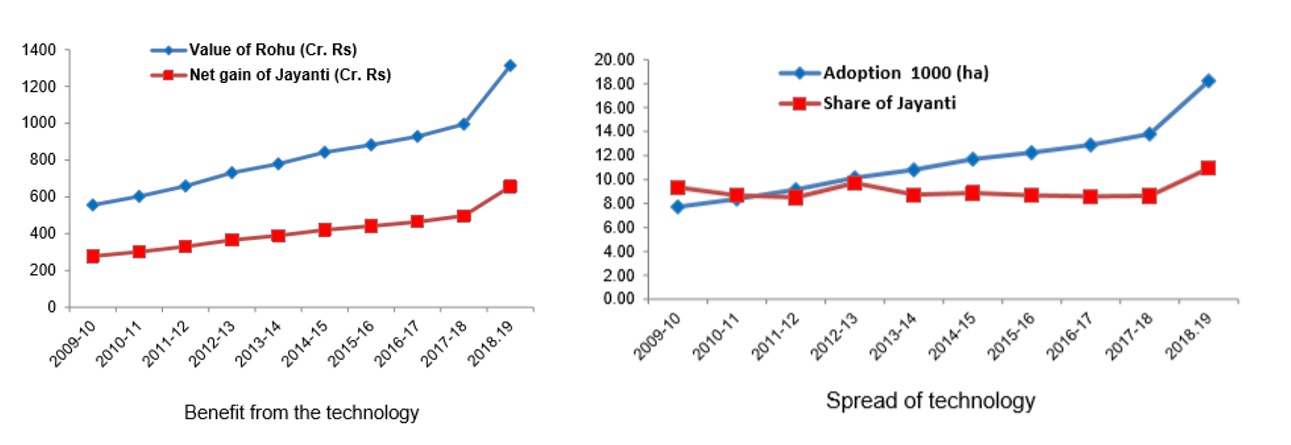
Most of the large commercial farmers are adopting these technologies to reach to the market is shorter time period which saves cost and interest on capital. TATA Amalgamated (PVT) Ltd. is culturing improved rohu over 5-6 years and as a multiplier unit supplying seed to different parts of Assam and other North Eastern states. The company is successful in establishing the brand name as supplier of quality seed because of Jayanti rohu.
- In the state of Bihar, Jayanti rohu dissemination started for last three years and farmers have created small hubs for dissemination of fingerlings to other fish farmers at fingerling stage. They collect Jayanti rohu at spawn stage from the nucleus and rear them for fingerlings. Due to high growth potential and local demand, they are getting minimum 50% profit so the demand is increasing every year. Same is the case with the state West Bengal.
- The demands are also received from all most all states of India and other SAARC countries and nucleus as well as the National Brood Bank is supplying seed to different states of India. It will be possible to disseminate the seed to SAARC countries after due approval of National Bio-Diversity Authority (NBA) of India.
Farmers – scientist interaction meet on importance of quality fish seed in aquaculture
- Farmers – scientist interaction meet on Importance of quality fish seed in aquaculture at Kakdwip, West Bengal
- Farmer - Scientist interaction meet on “Quality seed and feed for Aquaculture development at Berhampore, Mursidabad, West Bengal on 7th May 2015
- Farmers Scientists - Interaction Meet On 'Carp Broodstock Management And Quality Seed Production’ on 22nd September 2015 at Thanjavur, Tamil Nadu
- Jayanti Multiplier and outreach: Improved variety fish seed has been supplied to many stake holders. Farmers has been practicing scientific farming for Jayanti rohu in more than 10 states as well more 16 district in Odisha
- Quality seed as concept: Concept of quality seed has been conveyed to many stake holders. In an attempt NFDB, Hyderabad has come forward to sign a MOU with ICAR CIFA to popularize the quality fish seed production concept a well to advice the farmer to grow improved variety fish in India. The concept of quality seed was appraised to Secretary, Department of Animal Husbandry and Fisheries in three occasions to sensitize policy makers.
CIFABROOD:
Presently, around 90 tonnes CIFABROODTM is being produced and distributed among farmers which roughly amounting to feeding of 80 tonnes of broodstock in the country. The technology is being adopted by famers of West Bengal primarily to mature and induce breed in the pre-monsoon period (April-May), where price of spawn is very high (800-1200/lakh spawn). Whereas in other states, the feed is used to produce higher number and better quality spawn. In Tamil Nadu farmers are able to breed the fish in the month of December using this technology is a major breakthrough in the country.

CIFABROODTM demonstration: The broodstock diet has been demonstrated in 5 states (Odisha, West Bengal, Chhattisgarh, Bihar and Tripura) during report period. Total of 15 hatcheries from 5 states has taken demonstration of CIFABROOD and the results have been encouraging. The quality of seed has been improved as well the seed availability period has been extended.
- Early and repeat breeding of Java punti (Puntius gonionatus) in 2014 at Kuliagarh, Naihati in N-24 PGS district of West Bengal was observed by Mr Tapan Patra
- Early breeding of the IMC was reported at the hatchery of Mr. Debsaran Ghosh (45years) of Rashbeluria, in Murshidabad in 2014
- KVK Bhadrak tested ‘CIFABROOD™’ brood-stock diet in increasing breeding performance of catla by OFT on CIFABROOD™ in two numbers of hatcheries of Bhadrak district namely: - Radhakrushna Pvt. Carp Hatchery, Tentei (Hatchery-1) and OPDC Fish Seed Hatchery Project, Saramanga (Hatchery-2) in 2014
Technology commercialization:
CIFABROODTM
- M/s-Aisharya Aquaculture Pvt. Ltd. Naihati, West Bengal was selected and issued order for technology transfer agreement vide CIFA order 313/CIFA/Estt./2013 dt 07/08/2013 at a price of Rs.3,11,000/. Commercialization of the technology was done on 29th August 2013 at NASC Complex, PUSA, New Delhi with the signing and exchange of MOU between the Director, CIFA and the Proprietor of Aisharya Aquaculture Pvt. Ltd. Naihati, West Bengal., Mr Avijan Ghosh. Three technologies of CIFA were released by Dr S. Ayyappan, Secretary, DARE and DG, ICAR in presence of several dignitaries, among which CIFABROODTM was one of them.
JayantiTM Rohu
- A MoU for supply of improved rohu Jayanti to Tamil nadu Fisheries University and Aravind Fish Farm, Tamilnadu as a Jayanti multiplier unit was also signed for the period of 2015 to 2018.
- A MoU for establishment of JayantiTM rohu multiplier units in Chattisgarh, West Bengal, Odisha was also signed during 2018-19.
- The MoU for JayantiTM rohu Multiplier unit between ICAR-Central Institute of Freshwater Aquaculture (ICAR-CIFA), and M/S Amalgamated Plantation Private Limited (A TATA Enterprise) Guwahati, Asom was signed for three years (29.01.2019 to 28.01.2022)
Special Attainment By Staff: (Research/socioeconomic development/participation in special seminars/ symposia/ curricular-cultural activities, etc.)
| Dr. J. K. Sundaray |
|
| Dr. P. Das |
|
| Dr. K. D. Mahapatra |
|
| Dr. J. Mohanty |
|
| Dr. A. Barat |
|
Training programme conducted by the Division:
| # | Name of training | Duration |
|---|---|---|
| 1 | Training on Genetics and Molecular Biology techniques and their application in Aquaculture | 18-28th Aug. 2014 |
| 2 | Training on Molecular Biology and Biotechnology for Fisheries Professionals | 15th May - 15th Aug. 2015 |
| 3 | Advance Tools for Genetic Improvement of Aquaculture Species: An integrated approach | 10th June - 30th June 2015 |
| 4 | Bioinformatics Tools for Fish Genomics | 21 - 22nd May - 2015 |
| 5 | Training on Molecular Biology and Biotechnology for Fisheries Professionals | 1st Nov. 2015 - 31st Jan. - 2016 |
| 6 | Electronic Tagging Demonstration to State Fisheries Department Officials of Tamil Nadu State | 26th - 27th April - 2017 |
| 7 | Workshop on importance of quality fish seed and growth evaluation of Jayanti rohu in low saline water | 27th Feb. - 2017 |
| 8 | ICAR sponsored short course on Broodstock Improvement and Quality Fish Seed Production through Genetic Tools | 15th - 24th Mar. - 2018 |
| 9 | Dissemination of minor carp production technology and its refinement for greater adaptability by aquaculture farmers | 24th Jan. - 2019 |
| 10 | Hands-on training on molecular biological and computational tools | 16th - 25th Apr. - 2019 |
| 11 | A Focus Group discussion was conducted on14th July, 2019 at East Kolkata Wetlands with an aim to know the problems associated with the presence of exotic sailfin catfishes (Pterygoplicthys sp.) in the IMC culture ponds of EKW. A total of 18 fish farmers/stakeholders attended the program. | 14th Jul. - 2019 |
| 12 | Coordinated in-plant training for B.F.Sc. students for college of fisheries Raha Assam during from FGB Division | 20 - 22nd Jul. - 2019 |
| 13 | DBT sponsored training on genetics and genomic data analysis in aquaculture | 19th - 28th Sep. - 2019 |
| 14 | Hands on training on “High Throughput Sequence Data Analysis” | 23rd - 30th Nov. - 2019 |
International Programme conducted
- 3rd International Symposium on Genomics in Aquaculture (ISGA-III) was organised during 21st -23rd January, 2020
- 2nd International Symposium on Genomics in Aquaculture (ISGA-II) was organised during 28th -30th January, 2016
- International consultation meeting on Fish Genomics on 23rd Jan, 2015
- Ist International Symposium on Genomics in Aquaculture (ISGA-I) was organised during 22nd -23rd January, 2013 attended by more than 180 participants
Outstanding publications which has/have been acclaimed
| # | Title | Journal | Authors | Year |
|---|---|---|---|---|
| Status of genetic and genomic approaches for delineating biological information and improving aquaculture production of farmed rohu, Labeo rohita (Ham, 1822) | Reviews in aquaculture, https://doi.org/10.1111/raq.12444 | K D Rasal, J K Sundaray | 2020 | |
| De novo assembly and genome-wide SNP discovery in rohu carp, Labeo rohita | Frontiers in Genetics https://doi.org/10.3389/fgene.2020.00386 | Das,P. Sahoo L, SP Bit, A., Joshi, CG., Kushwaha, B.,….Jena,J | 2020 | |
| Molecular characterization, computational analysis and expression profiling of Dmrt1 gene in Indian major carp, Labeo rohita (Hamilton 1822) | Animal Biotechnology DOI: 10.1080/10495398.2019.1707683 | Sahoo, S. Sahoo, M. Mohanty, M. Sankar, S. Dixit, P. Das, K. D. Rasal, M. A. Rather & J. K. Sundaray | 2019 | |
| Effect of salinity on survival, hematological and histological changes in genetically improved rohu (Jayanti), Labeo rohita (Hamilton, 1822) | Indian J. Anim. Res. DOI: 10.18805/ijar.B-380 | Murmu, K.D. Rasal, A. Rasal, L. Sahoo, P.C. Nandanpawar, U.K. Udit, M. Patnaik, K.D. Mahapatra and J.K. Sundaray | 2019 | |
| Liver-Specific microRNA Identification in Farmed Carp, Labeo bata (Hamilton, 1822), Fed with Starch Diet Using High-Throughput Sequencing | Marine Biotechnology DOI: 10.1007/s10126-019-09912-y | Rasal KD, Iquebal MA, Jaiswal S, Dixit S, Vasam M, Nandi S, Raza M, Sahoo 1, Angadi UB, Rai A, Kumar D, Sundaray JK | 2019 | |
| Revealing liver specific microRNAs linked with carbohydrate metabolism of farmed carp, Labeo rohita (Hamilton, 1822) | Genomics112(1):32-44 | Kiran D. Rasal, Mir A Iquebal, A Pandey, P Behera, S Jaiswal, M.Vasam, S. Dixit, M. Raza, L. Sahoo, S. Nandi, U.B. Angadi, Anil Rai, D. Kumar, N. Nagpure, A Chaudhari, JK Sundaray | 2019 | |
| Population structure and genetic diversity of hatchery stocks as revealed by combined mtDNA fragment sequences in Indian major carp, Catla catla | Mitochondrial DNA Part A Vol. 30, PP- 289-295 | L Sahoo, M Mohanty, PK Meher, K Murmu, JK Sundaray, P Das | 2019 | |
| Chitosan-eurycomanone nano formulation acts on steroid genesis pathway genes to increase the reproduction rate in fish | The Journal of steroid biochemistry and molecular biology Vol. 185, PP-237-247 | Irfan Ahmad Bhat, Irshad Ahmad, IshfaqNazir Mir, Raja Aadil Hussain Bhat, P Gireesh-Babu, MukundaGoswami, JK Sundaray, Rupam Sharma | 2019 | |
| Genetic parameter for growth and survival in rohu carp (Labeo rohita) | Aquaculture 503(2019): 381-388 | Bjarne Gjerde, Kanta Das Mahapatra, P. V. G. K. Reddy, J. N. Saha, R. K. Jana,P. K. Meher, M. Sahoo, Hooi Ling Khaw, TrygveGjdrem | 2019 | |
| Development of a western blot method for detection of fish ectoparasite Argulus siamensis antigens | Journal of Immunoassay and Immunochemistry 39 (4), 439-450 | P Das, J Mohanty, MR Badhe, PK Sahoo, KK Sardar, SC Parija | 2018 |
